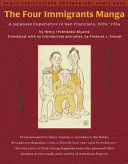
The Four Immigrants Manga: A Japanese Experience in San Francisco, 1904-1924
Written and illustrated by Henry Yoshitaka Kiyama
Translated by Frederik L. Schodt
Berkeley, California: Stone Bridge Press, 1999, 152 pp.
ISBN: 1880656337
“Cartoons are not jokes; they are observations about life, which isn’t serious.” (Wakasugi, 1931, p. 31 cited in Kiyama, 1999)
After centuries of relative isolation from the West, Japanese people began to emigrate in great numbers during the 1800s. They worked and studied overseas, including North America, South America, and the Asia–Pacific region, in order to seek a better life and opportunities as well as to help modernize their home country. In the early 1900s, about 400,000 Japanese immigrated to Hawaii and California (Library of Congress, n.d.). Henry Yoshitaka Kiyama, a talented artist who mastered Western art techniques, was one of the first-generation Japanese immigrants to arrive in San Francisco. In The Four Immigrants Manga: A Japanese Experience in San Francisco, 1904–1924, he uses gentle humor and satirical irony to address his immigration experience, including the themes of marginalization, alienation, confusion, and dilemma.
The Four Immigrants Manga begins with four Japanese youths—Henry, Charlie, Frank, and Fred—sailing to San Francisco to pursue their individual dreams. Henry hopes to study Western art to bring to Japan, Charlie wants to study the domestic systems of American society, Frank wishes to become an export–import businessman, and Fred dreams to become a “potato king,” a successful California farmer. Henry is modeled after the author himself, whereas the other three characters are based on real people the author knew. Each has a different vision, yet on one level they all hold a nationalistic purpose for their immigration. They desire to become accomplished men so they can bring political, cultural, and social changes to their home country, Japan.
They expect a wonderful life in the United States, but the reality proves different. They struggle with foreign culture, customs, and language and face occupational downgrading and racism. They toil in domestic work as houseboys in European-American households and as field workers for wealthy white landowners. Although they live a hard life stuck between two spaces—a home country and a host country—they maintain “homeland orientation” (Brubaker, 2005, p. 5), keeping a collective memory about Japan and staying committed to Japan’s prosperity. In addition, they demonstrate “boundary-maintenance” as they try to maintain cultural identities through close social relationships with other Japanese immigrants and experience the “unintended consequences of social exclusion” such as racism (p. 6). Along with the youths’ daily lives, the story also conveys their experiences with and adjustments to historical events and problems, such as the 1902 San Francisco great earthquake, the Panama–Pacific International Exposition of 1915, World War I, the 1918 influenza epidemic, and Prohibition in 1918.
In 1904, at the age of 19, Kiyama sailed to San Francisco, where he lived until 1937. He attended the San Francisco Art Institute to study fine arts and opened his own art studio in Japantown. In 1931, he self-published The Four Immigrants Manga in Japanese. In 1999, the book was translated into English and published by Frederik L. Schodt, an award-winning author of multiple books on Japan. Inspired by American comic strips, Kiyama illustrated the book with the flow of the English left-to-right sequence, just like an American comic style. In addition to the comic story, the book provides extensive historical notes about Asians’ immigration history.
This graphical documentary and autobiographical story offers a glimpse into the life of Japanese immigrants in the United States and their interplay with historical events. Readers may notice some stereotypical depictions of other races, such as Chinese and African Americans, that are “by no means ‘politically correct’” (Schodt, 1999, p. 17 cited in Kiyama, 1999). The author includes such images on purpose for historical accuracy. This serves as an example of the prevalence of racism of that era and invites readers to consider issues related to immigrant-related racism during that time and in today’s society. In addition, the story may provide readers opportunities for critical discourse analysis; for example, they may explore interactions and social relations between Japanese immigrants and white employers. It may also open up discussions about the struggles that many immigrants face in a new country, such as misunderstandings caused by cultural and language differences.
The Four Immigrants Manga can be paired with several works of diasporic literature presenting homeland orientation and boundary-maintenance, including A Jar of Dreams (Yoshiko Uchida, 1981); Angel Child, Dragon Child (Michele Surat & Vo-Dinh Mai, 1983); Children of the River (Linda Crew, 1991); Grandfather’s Journey (AllenSay, 1993); Blue Jasmine (Kashmira Sheth, 2004); Little Cricket (Jackie Brown, 2004); The Not-So-Star-Spangled Life of Sunita Sen, originally published as The Sunita Experiment in 1994, (Mitali Perkins, 2005); and The Arrival (Shaun Tan, 2007).
References
Brubaker, R. (2005). The ‘diaspora’ diaspora. Ethnic and Racial Studies, 28(1), pp 1-19.
Immigration of Japanese: Introduction. (n.d.). Retrieved from Library of Congress website: http://www.loc.gov/teachers/classroommaterials/presentationsandactivities/presentations/immigration/alt/japanese.html
Kiyama, H. Y., & Schodt, F. L. (1999). The four immigrants manga: A Japanese experience in San Francisco, 1904-1924. Berkeley, Calif: Stone Bridge Press.
Junko Sakoi, University of Arizona, Tucson, AZ
WOW Review, Volume VI, Issue 4 by Worlds of Words is licensed under a Creative Commons Attribution-NonCommercial-ShareAlike 4.0 International License. Based on work at https://wowlit.org/on-line-publications/review/vi-4/
